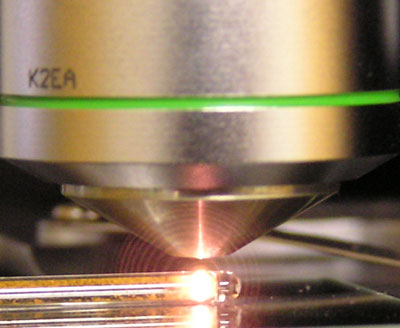| Posted: Mar 17, 2010 | |
New fullerene discovery sparks research into medical and industrial applications |
|
| (Nanowerk Spotlight) It has been known for several years that carbon nanotubes would heat, ignite and luminesce upon exposure to certain types of electromagnetic radiation, including laser light. However, no one expected any form of fullerenes to do the same thing. Until now. A team at the University of Florida, led by Brij Moudgil and Ben Koopman, has discovered that functionalized fullerenes heat, ignite, glow and transform into other carbon nanostructures such as carbon nanotubes upon exposure to low-intensity laser light. This is the first time these findings have been published. | |
| "We have shown that certain functionalized fullerenes, including polyhydroxy fullerenes – which are known to be environmentally safe and to have therapeutic properties – are heated or ignited by exposure to low-intensity continuous-wave laser irradiation" Vijay Krishna tells Nanowerk. "We also show that polyhydroxy fullerenes and other functionalized fullerenes can be transformed into single-walled nanotubes, multiwalled nanotubes and carbon onions without the presence of a catalyst by exposure to low-intensity laser irradiation in an oxygen-free environment." | |
| Krishna, a post doctoral associate at the Particle Engineering Research Center at the University of Florida, Gainesville, is first author of a paper published in the March 14, 2010 online edition of Nature Nanotechnology ("Optical heating and rapid transformation of functionalized fullerenes"). In it, he and his collaborators argue that the possible explanation for the optical heating and ignition phenomena that they observed is a distortion of the symmetrical cage structure of the fullerenes. | |
| "Energy provided by laser is sufficient to break the distorted cage" says Krishna. "The collapse of the strained cage structure releases additional energy in the form of heat. Concomitant with heating is the emission of light. In the presence of oxygen, emission arises in the form of a spark immediately preceding ignition for functionalized fullerenes with low threshold intensity. For functionalized fullerenes with higher threshold intensity, the material glows for 1–10 seconds before it is transformed into a black residue." | |
 |
|
| Visible light emission from functionalized fullerenes with a 785 nm laser. (Image: Particle Engineering Research Center at University of Florida) | |
| Using intensities as low as 1 x 102 W cm-2, the team has demonstrated laser-induced ignition with near-infrared (785 nm), green (540.5 nm) and blue (488 nm) laser radiation. The threshold laser intensity for ignition and the heat generated in the presence of atmospheric oxygen depend on the type of functionalization. | |
| The researchers also found that functionalized fullerenes, following irradiation for less than one minute in an oxygen-free environment, were transformed into single-walled carbon nanotubes, multi-walled carbon nanotubes, carbon onions and possibly other carbon nanostructures. It appears that the transformation of functionalized fullerenes to carbon nanostructures occurs over a range of wavelengths and, furthermore, the threshold energy for the transformation is wavelength-dependent. | |
| The team proposes a range of potential applications for this discovery in medical, electronic, energy and advanced materials sectors: | |
|
|
|
| "The photothermal and photoacoustic properties of carbon nanotubes make them attractive for cancer therapy, but they are not biodegradable and accumulate in certain organs such as liver and spleen" says Krishna. "Polyhydroxy fullerenes have the same therapeutic properties and in addition are biocompatible and are rapidly eliminated – polyhydroxy fullerenes are 1.3 nm in size, which is below the renal filtration limit of 5.5 nm." | |
| One of the primary challenges for the team is now to verify and improve the proposed model of functionalized fullerene heating, luminescence and transformation into nanostructures. | |
| Further challenges include exploration of the complete spectrum of electromagnetic radiation to find which bands interact with functionalized fullerenes, optimization of molecular structure for various applications, and understanding how these molecules interact with electromagnetic radiation. Additionally, integration of these phenomena into useful products and their commercialization is another challenge. | |
 By
Michael
Berger
– Michael is author of three books by the Royal Society of Chemistry:
Nano-Society: Pushing the Boundaries of Technology,
Nanotechnology: The Future is Tiny, and
Nanoengineering: The Skills and Tools Making Technology Invisible
Copyright ©
Nanowerk LLC
By
Michael
Berger
– Michael is author of three books by the Royal Society of Chemistry:
Nano-Society: Pushing the Boundaries of Technology,
Nanotechnology: The Future is Tiny, and
Nanoengineering: The Skills and Tools Making Technology Invisible
Copyright ©
Nanowerk LLC
|
|
|
Become a Spotlight guest author! Join our large and growing group of guest contributors. Have you just published a scientific paper or have other exciting developments to share with the nanotechnology community? Here is how to publish on nanowerk.com. |
|
